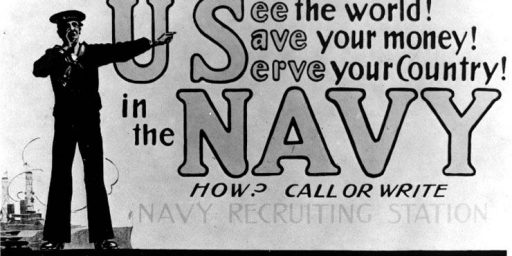Most Youth Ineligible for Army
The Army’s pool of eligible recruits is shrinking.
Close to three-quarters of American youth are ineligible to serve in the Army and patriotism among the country’s recruitable population has been sliding since 2002. That was the assessment of a series of recent surveys conducted in fiscal 2006 and early fiscal 2007 by the Army’s Center for Accessions Research and presented Thursday by Gen. William S. Wallace, commanding general of Training and Doctrine Command. “It’s an Army problem, but it’s also a national problem,” said Wallace, who presented a slice of the report at the winter meeting of the Association of the United States Army.
[…]
According to Wallace, only 27 percent of youth between the ages of 17 and 24 are eligible for recruiting. The remaining 73 percent, he said, “are morally, intellectually or physically” unfit for service. “It’s the lowest it’s been in more than 10 years.”
I’m curious to see what the breakdown is. Presumably, there are as many or more high school graduates now. So, my guess is that either more people are experimenting with illicit drugs or are too fat. (I called the Center for Accessions Research and was told I’d need to contact the Army Public Affairs office, which I have. I’ll update if I get hard data.)
Wallace has another problem:
College, he said, is now the preferred post-high school activity and youths surveyed said they perceived the Army as “ordinary.” According to Wallace, those surveyed considered the Marine Corps “elite but dangerous.” They considered the Navy “somewhat elite but safer” and the Air Force was considered “elite and highly technical.”
That’s probably not an unreasonable perception, really, depending on how one defines “elite.” Clearly, the Air Force and Navy are more technically oriented than the Army and the Marines are generally more physically demanding. The Army is by far the biggest service and almost certainly the one with the most variety of missions and standards.
Given that we have an all-volunteer force and are in the middle of a long war, recruiting is naturally difficult. One would think that if one’s goal were front-line combat, the Marines would be the most appealing and that if one wanted the benefits of military service while minimizing the risk of bodily harm, the Navy and Air Force are the logical choices. The Army, then, is in something of a no-man’s land.
via email tip from Bill Jempty





True, but the standards of “morally, intellectually or physically” fit ought to be reasonably static. I wonder what the breakout among those categories was – are kids less fit, dumber, or more likely to have a criminal record these days?
I wonder what the breakout among those categories was – are kids less fit, dumber, or more likely to have a criminal record these days?
Great minds apparently think alike. (See second paragraph of the above post.)
There is a 2006 article that goes into a bit more on what constitutes “eligible” as opposed to ineligible but can get in with a waiver.
Prior to some of the changes, the pool was 42% eligible. It is also good to keep in mind that at 42% eligible, the army failed to meet its recruitment goal in 2004. At 27% eligible, they met their goal in 2006.
The 2004 numbers had 24 million youth between 16 and 21. 14 million ineligible, 6 million of the remaining 10 million going on to college (and presumably eligible when they graduate or decide college isn’t for them) and this leaves 4 million who are eligible and not going on to college for whatever reason.
Given that the Army wants at least 60% of its recruits in the top half of the mental distribution (which you would think that top half is mostly going on to college), you start to get a feel for how hard it is to meet the recruitment goals.
Yeah, I must’ve blanked on that para. Or maybe just subconciously agreed 🙂
YAJ, you point out that the Army is meeting its goals now, but haven’t those goals themselves been lowered in recent years? And also – just wanting to go to college ain’t enough; you have to have increasingly greater sums of cash to get there. I would expect the offer of GI Bill $$, tuition reimbursement, ROTC scholarships, etc. to balance out the greater percentage of HS grads with college in mind.
Back in those long-lost days of late 2001, many libertarians imagined that, surely, the government would have to choose between waging an all-out terror war and waging an all-out drug war. Instead, the government not only tried to do both, it tried strenuously to tie the one to the other.
Oh well!
Also in the “morally unfit” category: every gay kid in America, according to the military anyway.
The “fat” thing I don’t understand, though. Isn’t basic a pretty effective weight-loss program? I’d think a fat kid who really wanted to join the Army could motivate himself to lose weight and run that eight-minute mile. Question: Are childhood diabetes and asthma disqualifiers? Perhaps the incidence of diseases like that are what’s going up.
Jim,
All good points.
I’m sure the survey is of the state of the age pool as is. Certainly, someone sufficiently motivated to join the Army could lose weight, but that wouldn’t be reflected in a cohort study.
I’d certainly prefer the Army lower its standards as to how many joints a person has smoked in his lifetime rather than the IQ standard.
And, yes, I’m pretty sure asthma and diabetes are disqualifying.
Asthma is disqualifying for the Navy (although if diagnosed after entry it doesn’t require a medical discharge-my husband was roomates with a guy who was diagnosed post boot camp).
So, my guess is that either more people are experimenting with illicit drugs or are too fat.
I would also add that a diagnosis such as ADD or ADHD (or other similar disorder) where the graduate is still taking medications disqualifies them from service. These diagnosis have been on the rise for years, I wouldn’t be surprised if there is a higher percentage of graduates with the diagnosis than there was 5 or 10 years ago. A person can get into the military with these diagnosis, but they have to have been off their medications for I think 5 years before they attempt to enlist.
I do think competeing with college is a problem for any branch of the military with regards to recruitment.